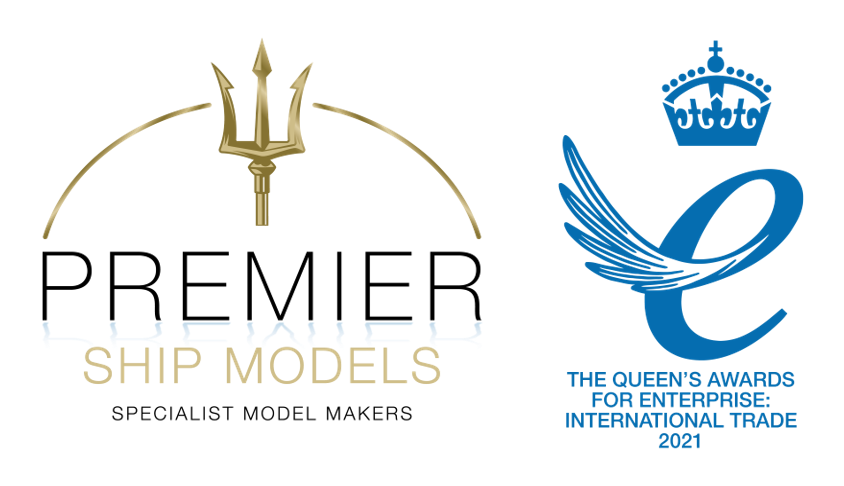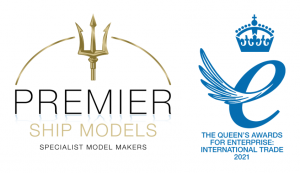Storylines specialise in cruise liners, providing accommodation for those who wish to live at sea on a full-time basis. Their ships provide a fantastic quality of life for those on-board, with cinema and theatre, brilliant cuisine and extraordinary local entertainment.
In early 2023, Premier Ship Models were contacted by Storylines. They requested a quote for six models; three of their brand-new MV Narrative cruise liners, and three of an apartment aboard the Narrative, named RU4.3. These models were to be of sublime intricacy and detail, and needed to be identical to each other in every way.
A pair of models (one MV Narrative and one RU4.3) was to be delivered to three separate locations around the world. This case study focuses on the RU4.3 models.
This was an unprecedented challenge for Premier Ship Models, but one we approached with keen enthusiasm, hopeful to expand our horizons and impress on a new front!
As stated above, Storylines is a world-renowned residential high-end cruise line, based out of Miami, Florida. They have successfully created a keen seafaring community whereby residents can experience fantastic adventures, whilst partaking in healthy and active lifestyles.
They’re also proud members of the UN Global Compact and Pledge 1%, reflecting their strong beliefs in a more sustainable and pro-environment business structure.
All three RU4.3 models were to be 3D printed, with construction taking place with our agent in the Far East.
3D-printing is an incredibly complex profession. It requires you to understand three main things:
- The material
- The printer
- The methodology of the piece and your desired end result
The entire process is extremely specialist. Our aforementioned agent focuses on two skillsets when constructing models: creating the model in a digital manner and readying it for printing, and the separate skillset to take the parts from the printer and get them to a professionally high-standard.
For the RU4.3 models, they measured 35.5 inches in length, 31.5 inches in width and 7.5 inches in height, allowing for plenty of room to show off the exquisite levels of detail.
In centimetres, this equates to 90 in length, 80 in width and 19 in height, meaning the model measures in at a scale of 1:15.
Furthermore, one of the walls was made from plexiglass, to allow you to see in from both the side and of course, the top.
To construct the models, 3D simulation modelling and subsequent laser-cutting were to be utilised, before then of course 3D printing.
Every custom project that Premier Ship Models carries out always starts with liaising with the client as closely as possible, agreeing on production times, pricing, model sizes, colours and whatnot. This guarantees that we bring their vision to life exactly how they want. We aim to be as transparent as possible, allowing the client to see the progress of their order. This also includes agreeing on things such as delivery time and payment terms.
Then Premier Ship Models assigned the client with a Production Manager, Project Manager and Client Manager, each responsible for separate parts of the process. A production order is created so everyone knows due dates and responsibilities.
As mentioned before, the models were to be 3D printed, and so digital renders needed to be made. The models were constructed with high-precision photosensitive resin, acrylic and timber, and we utilised 3D simulation modelling, together with laser-cutting.
The process for the RU4.3 models was much the same as usual, however, smaller pieces required more precision.
For the sake of efficiency, production is temporarily paused, so the client can sign-off on the digital renders. Once this is done, production can continue. This is treated with a great deal of urgency, to save time and resources, and streamline efficiency. We obviously cannot continue if the client is displeased with the plan, but this happened without a hitch.
One of the trickiest stages is converting the digital render into a file that is compatible with the 3D-printer, and so certain software has to be used to achieve this. Before this is done, the render itself is split into chunks – which are actual parts of the model (albeit digitalised) – and accordingly named and saved where appropriate. After this, another piece of software is used to ensure the parts are ready to be printed; making sure they’re of the right scale, are sturdy enough and watertight.
When the renders are ready, they can be printed via laser-cutting, and then building can begin. The construction itself is obviously the hands-on section, where specialists are required. It is known as the ‘finishing.’
The models required great precision and patience, as they can sometimes be very delicate in the earlier stages.
Throughout the entire process, photos and renders were frequently sent to the client to ensure they were happy with the progress, and any feedback was welcomed and subsequently incorporated.
Having never done a project like this before, Premier Ship Models were thrilled with the opportunity, and it was an honour to work with a company as prestigious as Storylines. So far, we have delivered a pair of models to the first location, with the remaining two to follow in the coming weeks.
We’re thrilled with the outcome of the project at this stage, especially the sheer detail of every model. It was a challenging yet extremely rewarding process, but overall, a huge success! We can’t wait to hopefully work on similar projects in the future, as well as diversifying and broaching out into other areas of modelling.
Commission your own model
If you would like to have your own bespoke model built, please complete the contact form below.


